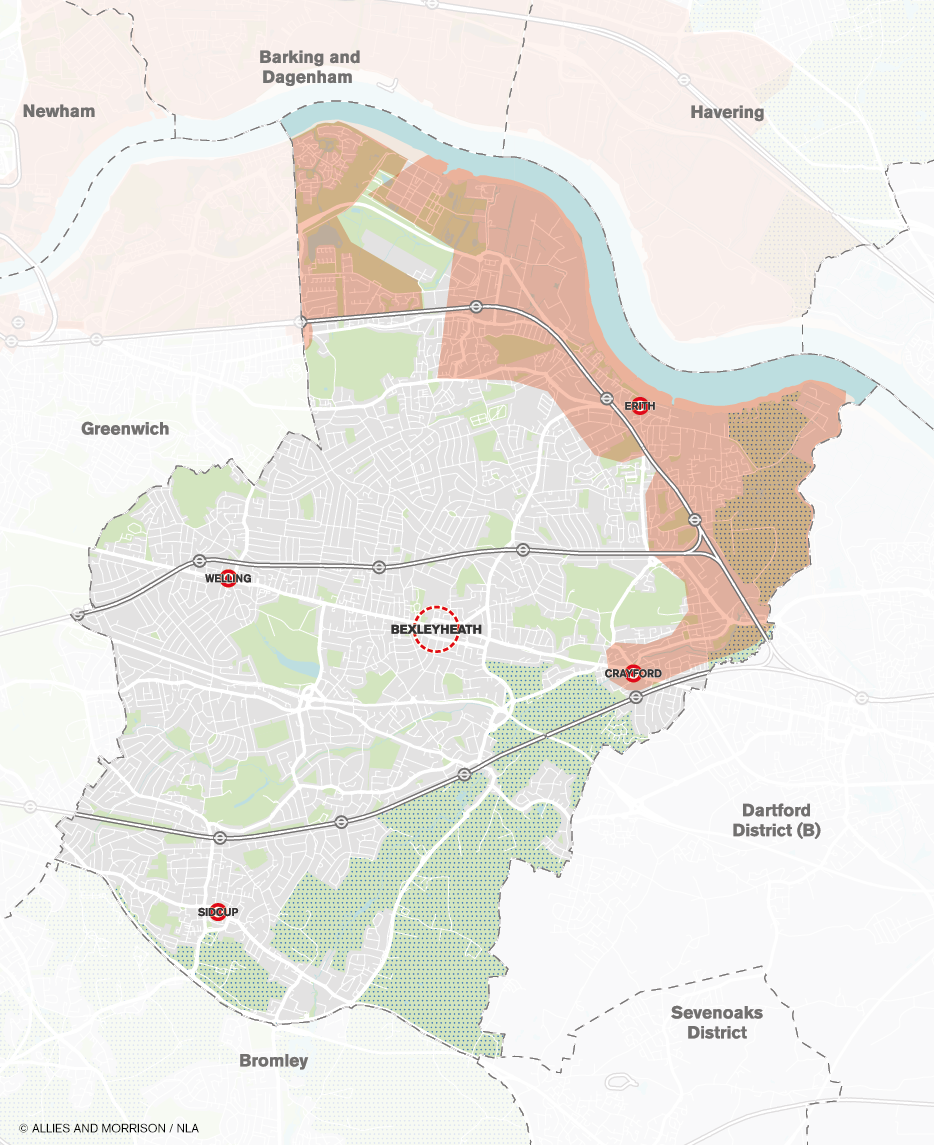

 Investment Opportunities
Investment Opportunities Opportunity Areas
Opportunity Areas Area of Intensification
Area of Intensification Central activity Zone
Central activity Zone International or metropolitan
International or metropolitan Major
Major District
District Borough Boundary
Borough Boundary Green Belt
Green Belt Metropolitan open land / Other open spaces
Metropolitan open land / Other open spaces Rail station
Rail station Railway track
Railway track Foreshore
Foreshore Water
WaterBexley is in south-east London within the Thames Gateway. The borough covers 23 square miles, bordered by the Thames in the north, Bromley to the south, Greenwich to the west and Dartford to the east. It has more than 90 parks and woodland areas, making it one of the greenest boroughs in London. It is also recognised as one of the safest boroughs in London.
With river views, Bexley’s riverside stretches nine kilometres along the south bank of the Thames between Greenwich and Kent, it has one of the highest levels of available industrial land in London and a large local labour force. It is home to a significant logistics industry – hosting the likes of Tesco.com and Ocado - but also boasts a growing number of small and micro businesses. It’s a Borough that has a rich heritage, historic houses and landmarks and that is focussed on the future, enabling new development and nurturing innovation.
Bexley has excellent road and rail connections, with the Elizabeth Line service running from Abbey Wood in the north of the Borough through central London to Heathrow and Reading, and there are ambitions to take the service to Ebbsfleet in Kent connecting Bexley, Dartford, Gravesham and coastal East Kent.

GLA Population projections 2022 250,251
GLA Population projections 2040 266,492
“Bexley is a thriving borough that has the best of both worlds – close to the centre of London but it is still a green, safe and friendly place to be.
With our riverside locations, strong community spirit and parks and woodland areas, the Borough is a popular place to put down roots and for new businesses to flourish. We have always been a Borough envied for our schools and are recognised as one of the safest and greenest places in London with huge potential for growth.
Our mission is to make Bexley even better.
We are ambitious for our borough – we want to secure investment so that current and future generations continue to live and work in a prosperous place. New housing developments are sweeping away old housing estates and replacing them with good quality, modern homes. Commercial investment in our towns and employment areas is creating new jobs and improved local facilities. The arrival of the Elizabeth line in the north of the Borough opens more exciting opportunities, but our ambitions for Bexley go further, and as a leading member of the Thames Estuary Growth Board, we are lobbying for the service to be extended to Ebbsfleet in Kent connecting Bexley, Dartford, Gravesham and coastal East Kent.
We continue to invest in our borough’s future and would welcome conversations with investors who share our vision for growth in our unique corner of London.”
Growth Strategy: the council has adopted a Growth Strategy, which is a propositional document setting out the boroughs potential to provide up to 31,500 new homes and 17,500 new jobs to 2050 should appropriate infrastructure be secured. The Strategic Vision states that Bexley will play a key part in helping London grow sustainably, whilst respecting the borough’s overall character and identity. New and existing communities will be strong, sustainable, cohesive and prosperous. A well-connected borough, both within and beyond Bexley, provides the key to securing growth opportunities for residents and businesses. People across the borough will have a better quality of life and improved wellbeing, supported by high quality housing, rewarding employment opportunities and effective local services and facilities.
Good growth will be secured by focussing new residential development on a series of well-connected public transport nodes, making the most of Bexley’s riverside location and industrial heritage. Core industrial areas retained for employment uses will be improved and intensified, fostering the growing movement of artisans and other manufacturers. The borough’s valued suburban heartland and quality open spaces will be preserved and enhanced. Shopping, culture and leisure facilities will be vibrant, supported by innovative industries and businesses.
The principles of the growth Strategy have been carried through to the Bexley Local Plan which sets out how good growth will be delivered to 2036.